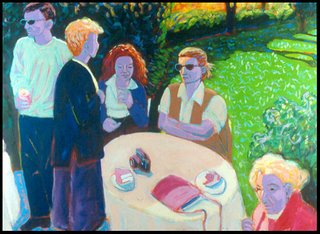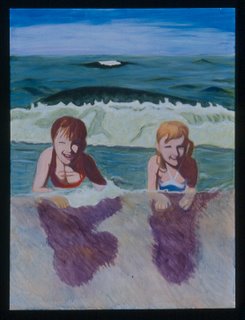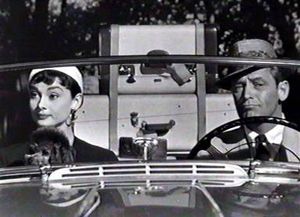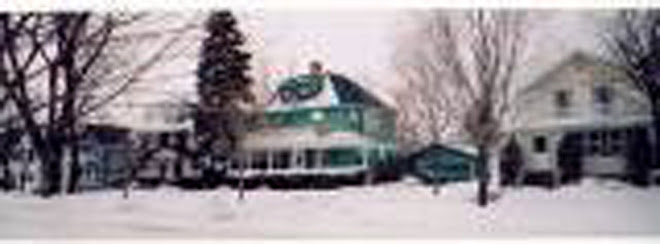Wednesday, June 28, 2006
stern wheeler
where ever nana sat, that spot became the commanding post. as stern wheeler, she had a chair nailed onto the row boat and would sit like royalty quietly reading as her sons, mostly david, rowed her on our beloved otter lake, donning a fedora.
to be fair, nana had a very soft and lovable side. giving birth to eight children and being married to a much to dapper irishman, she had to get tough. but in her later years she was endearing, poking roasted chickens, making us sugar sandwiches: take single slice of white bread, pour white sugar onto thick layer of wisconsin butter, fold over and eat like you are grinding sweet ocean sand...goosebumps!
i loved to stroke her black seal skin winter coat while we were in church or slip my hands into the mink muff with silk lining (it had a secret zippered pocket inside to put...what? lipstick?) that was probably used when she was young while ice skating or taking a romantic walk on a chilly northern night.
nana's later years were relaxed as she was in decompressing mode, enjoying the queenly service she had earned. she anchored in an entirely different century for us, with stories of the Chippewa Indians, the otter, the whippoorwill and fireflies. she gave us otter lake. and THAT is another story.
na na died one hot summer night in 1962. the air was heavy as rDs and i sat on the front lawn from where we could see the hospital a few blocks away. we counted the number of lights on the 6th floor, four from the right and stared at that little white square, knowing we would never see our na na again. and as we all know, all nana's must return to nature.
Tuesday, June 27, 2006
Nana (pronounced NAH-nah)
Auntie Ed lived on that same street, but in her own house. She had never married. On Sundays she and Nana would come to our house for Sunday dinner sometimes.
Nana loved sugar ... she even sugared her "orange drink", a concoction that was delivered by the milkman, manufactured from orange juice, water and sugar. It was delicious, but not nearly sweet enough for Nana, apparently. She would sugar her apple pie! She also loved her mashed potatoes.
After that Monroe duplex, I believe Nana moved into an apartment over near Astor Park, in a dim place I barely recall. She had a different exchange from us! She went from having a HEmlock number to having an EDison number (oh what an exotic exchange!). After that, she moved to a very large square (and very unattractive) house on Monroe, but closer to our house.
Finally she moved to Jackson Street, just a block away from our house. Once again, she was in a narrow tall Victorian, white this time. She grew tomatoes along the picket fence. She had her Mogen David and Maryknoll magazines on her round table, and a portrait of some unidentified woman on the wall, who looked vaguely like Aunt Lou-Lou.
Although with us she was very gentle and kind, Nana was a force to be reckoned with. I heard the stories of how she never spoke to this one or that one, ever since they ....
She was round and soft, like a potato roll, with twinkling blue eyes. Her hair had been very long, and she wore it in a coronet of braid around the crown of her head. Then some year or other, she had it cut off and wore her hair in a soft white halo around her head. She wore silk dresses that all blur into one in my memory, mid-calf length, belted loosely, with those old lady shoes ... Enna Jetticks, I think they were called, black laced-up oxfords with thick high heels. When she sat she crossed her ankles, and we could see how swollen they always were.
At our house she would request a "Pink Lady", which was a pretty soft pink drink with gin in it.
Sunday, June 25, 2006
918 Haiku
scatter like black tea leaves: my
grandma reads future
***
nightly childhood walk
neighbors seemed happy through my
blue eyes-now I am
Tuesday, June 20, 2006
A Grand Floating Ship

it seems like we learn how to relate to one another from many seemingly invisible influences. like the spot one's home occupies in relationship to it's neighbors and how it holds up next to each other. a sort of spacial intelligence emerges, a neighborhood arranges itself. and this sense of space and place probably shows up in our lives in many small and creative ways. homes take on personalities and characters in a neighborhood play. we grew up learning about our place in the world in this primordial way.
918 has such a warmth and dignity, plenty of room yet comfortable. it stands out and graces the block with a unique look. mother turned on every light in the entire house every night, curtains wide open. one neighbor loved to walk by and commented that our house looked like a grand floating ship.
my best friend, living next door, and i once stretched a long line of twine from our bedroom windows all the way across the shared driveway to play telephone with two tin cans as an ear receiver...bridging the gap. it really worked!
i can only imagine what the view was like from across the street, like in this picture, watching five little girls grow into five beauties. what a show that must have been. imagine all those possible suitors visiting incessantly, the door opening and closing year after year. if walls could speak...
Saturday, June 10, 2006
we don't need bodies, they whisper
goose bumps stand straight up;
a door opens and no one
is there- but ghostie
Mom's Mums

It seemed like Mom always had chrysanthemums in the house, usually white or yellow ones, growing in pots. She also had Christmas cactus and ... what was that plant with the spherical red-orange fruits on it? I have googled it, but no hits :(
Mom could get a bunch of flowers from the florist, greenhouse, or out of the garden, and arrange them into something that looked professional. She had skills that would have made any florist proud. Later on in life, she mostly bought flowering plants and cut flower arrangements ... I guess her illness and age were taking their toll, plus her vision was slowly failing.
Thursday, June 08, 2006
Happy Birthday, Mom

This painting was done from a photo I took at Mom's 80th birthday. Today would have been Mom's 90th birthday. She lived to be 87.
Mom loved parties of all kinds, and felt terrible if there were no special event practically every day. This frantic pace was more than I would ever want in my life, but she loved it.
The only thing better than parties every day, for Mom, would have been to live in a hotel.
Lou-Lou
She and Mom were really close. Mom loved to tell the story that one day she said to Lou-Lou, "Am I as tan as I think I am?" and Lou-Lou said, "TANNER!" at which they both roared with laughter.
Lou-Lou's husband was a football player with the early Chicago Bears. We called him Pops, and he had diabetes. He used a cane, but it was hollow and inside was a plastic tube filled with martinis! He used to tell jokes really well. One of my favorites of his was:
The Man With A Banana In His Ear
A man got on a train, and when he sat down he noticed the man opposite him had a banana in his ear. He thought it was really odd, but he felt a bit shy about saying anything. The miles went by, and his curiosity grew with every mile. Finally he could not stand it any more, so he asked, "Sir, why do you have a banana in your ear?"
The man replied, "You will have to speak up, I have a banana in my ear."
Lou-Lou moved to Boston after he died, and after some years she had a Boston accent of sorts. She said "to-mah-to" for instance. She also used her fork in a Continental fashion, left hand, tines down, not switching hands after cutting, as we had been taught. Mom was outraged that she had these mannerisms. I guess Mom thought these were affectations done for the sake of seeming more cultured or something.
Lou-Lou lost her vision but insisted on living alone until she died. She fell out of bed one night, and lay on the floor and waited till morning, rather than use her emergency button, which was around her neck. I don't really know why she did that, except she may not have realized that she was in a serious situation.
Later that day, she was lying on a gurney in the hallway of the hospital. Mom was with her, holding her hand. Lou-Lou asked what time it was. Mom said 1PM (or something), and Lou-Lou replied, "the Army-Navy game is just starting", and died.
The Peter Hunt Phase
Tuesday, June 06, 2006
Lake Michigan

Late in the summer we would go to Lake Michigan to swim in the cold green water and play in the rollers. In this picture Robyn and I were lying at the edge of the water, letting the waves wash over us and push our bodies up, then pull them back toward the lake.
We used to do this for hours on end. I almost always got a terrible sunburn with huge blisters on my back and shoulders. There was no sense of the strength of the sun because the air was always cool and the water was so cold that no one would swim except in late summer when the sun had warmed the surface water enough to be tolerable.
We would ride back to town in the station wagon, lying in the "way back" of the car, on our backs, looking up at the trees and power lines. Our view made them appear upside down through the windows. We were on heaps of pillows and quilts.
When we finally got to bed, as I grew quiet I would realize that my blood and nervous system was still in the rhythm of the surf. The feeling would sweep up my body, then back down, over and over, as I faded into sleep.
Starlight, Star Bright

Star Light, Star Bright, First Star I See Tonight; I Wish I May, I Wish I Might, Have the Wish I Wish Tonight. I wish for .... A DOG!
If only this were the story of a really GOOD little girl ...
Gypsy was the ugliest dog anyone had ever seen. She was a stray, with a mixture of black, brown and white fur, medium length, and curly, with flop ears and a heavy long body on short legs; large head, just not what anyone would call a beautiful dog. Somehow her ancestors had mixed too many variables or something.
She appeared in the neighborhood and ended up on Larry's porch steps. I saw her there and coaxed her home, foot by foot, inch by inch, and fed her. Larry was FURIOUS. Mom and Dad were HORRIFIED. My sisters were ... well, I don't know how they felt at first.
THEN .... it turned out Gypsy was in the family way. In fact, in a BIG family way. Within a few weeks of her arrival in our house she gave birth in the back hall, to eleven puppies! Three were born dead. Dad buried them in the back yard, but Gypsy dug them up. Dad buried them deeper; Gypsy dug deeper. I do not know the final resting place, but it was somewhere away from our yard.
It was summertime, and we were scheduled to spend two weeks at Point Comfort, at our rented cottage. Gypsy got "boarded" at The Pound, where stray dogs were kept in captivity and probably murdered. When we came back from the cottage, Gypsy had been spayed, and there were only two puppies left. Mom and Dad said that the puppies had died. I bet they had! The puppies were then named Tarbaby and Cinderella. We found homes for them eventually and they left.
In the picture above I was one one side of Gypsy in the back yard and Robyn was on the other side. I was SO possessive of Gypsy, I cut Robyn off the photo.
Gypsy became a neighborhood icon. My parents did not think dogs needed to be restrained, so she roamed free. Every day she followed the mailman on his route. People whom I have never met fed Gypsy treats all day long, and when she got home to her meal of canned dog food, she really was not terribly interested.
Gypsy was frequently infested with fleas, and we bathed her in the basement in a galvanized wash tub, with flea shampoo. During the bath, fleas would leap off her in cascades. At one time, she got some horrible skin thing, possibly mange, and her skin and fur came off easily in smallish patches. Under the skin were squirmy things EEEUW.
One evening when we were sitting on the front porch, Gypsy came up the steps and someone said maybe she would look better with her ears standing up. I held her ears up and everyone laughed. Gypsy was hurt and humiliated, and left immediately. I felt terrible.
I told Gypsy everything. I would sit with her and tell her of my hopes and dreams, my fears and hurts. She never told my secrets. She was a very affectionate and easy-going dog, and would put up with a lot of silliness from us children.
When I left home, Gypsy stayed with the family. Years later, she was napping in the middle of the street, as was her habit, and a neighbor ran her over with their car. Mom used to tell the story that when the sheriff brought her body home, the men present removed their caps in reverence. Gypsy had gone.
Saturday, June 03, 2006
Garages with Attics

One of the features of our (later called historic) neighborhood was that some of the garages had attics. On the northwest corner of our block was a very large house with a VERY large garage, owned by several families while I lived at 918. The garage was a "carriage house" along the lines of the one in the movie Sabrina. In that film, Audrey Hepburn portrays a young girl, daughter of the chauffeur for a wealthy family. She lives above the garage and observes the rich people from there. Sabrina even tries to kill herself in that garage. The carriage-house-style garage on our block did not, to my knowledge, have a chauffeur living above it, but it had a suite of rooms up there, and there were at LEAST four garage doors.
Sadly, one of Mom's friends, Mrs. C_____, who lived in the large house on the corner, later committed suicide in the house, the tragic death of a dear shy woman.
The other memorable garage attic was the G________'s family garage, down near Monroe Street. It was also a corner house (what IS that about?), and above the garage was a dusty attic with mysterious trunks. It had a window, so we could see all the wonderful things inside. One glimpse was enough to burn it into my brain. Trunks and old fashioned furniture and clothing! How magical these things are to a child!
The Attic and the Basement
The room was floored in linoleum, as were all the bedrooms. there was an iron bedstead with one of those simple springs and a thin cotton-stuffed mattress with blue and white striped ticking. I adored that room and spent many hours playing that I was grownup and living on my own up there.
Outside the room was a dim mostly empty attic. The wood of the high roof was visible, kind of reddish brown. It was very airy up there, especially compared to present-day attics. In the center were the stairs. They were very narrow and steep, each stair covered with thin rubber with ridges for safety; but for some reason our parents stored things on the stairs, even though just at the top was a lot of room.
Facing the front of the house, there were extra dining room chairs stored to the right, in the very darkest part of the attic. That part was scary. To the left of the room there was some storage that was in use. That is where the wicker baby bassinet sat for many years.
On the back side of the attic were two very large cisterns, rusty and empty, which had been used to capture rainwater. I always thought that was an excellent idea, and wondered why they had stopped doing that, and why those giant tubs were left embedded in the floor of the attic. Our parents did not do much with things that were not in their way, so I guess they did not see the point of removing the things. They were invisible to daily life. We were warned to stay out of the cisterns, and we did. They looked fragile. Maybe we would have fallen through to the bathroom! Looking back, I think we could have fallen into one of them and not been able to get out.
The basement was built of granite stones, and in the center was an enormous oil-burning furnace with large round ducts reaching out of the top in all directions. I think it had been coal-burning at one time. There was a coal storage area and what had been a coal chute.
There was a particular smell to the basement, of earth and stone and concrete and water and mold. For a long time, Mom did laundry down there, using a wringer washer. There was a hole in the concrete that served as a drain. How depressing that must have been! It was dark, grey dank and grim down there. During the Great Remodeling a washer AND DRYER were put in up in the kitchen, where there was light and air. It was quite a change for Mom, and I am sure she was very pleased.
There were old photographs of unknown dead relatives down in the basement, which we finally took away after Mom and Dad moved to a retirement home. Neither Mom nor Dad could remember who some of them were!
Mom used to make currant jelly up in the kitchen (from currants we picked from our bushes in the back yard), but after she poured the wax on the top of the clear red jelly, she stored the little jelly glasses in the basement on shelves.
In one corner was the "rec" (recreation) room, also known as a rumpus room. It had the old benches from the breakfast nook and a corner cupboard in it. When Poet was a teenager, it became the spot for a lot of parties. We younger ones liked to race around the house, down into the basement, into the rec room, and climb out the high window onto the grass beside the lilacs, only to race around once again.

